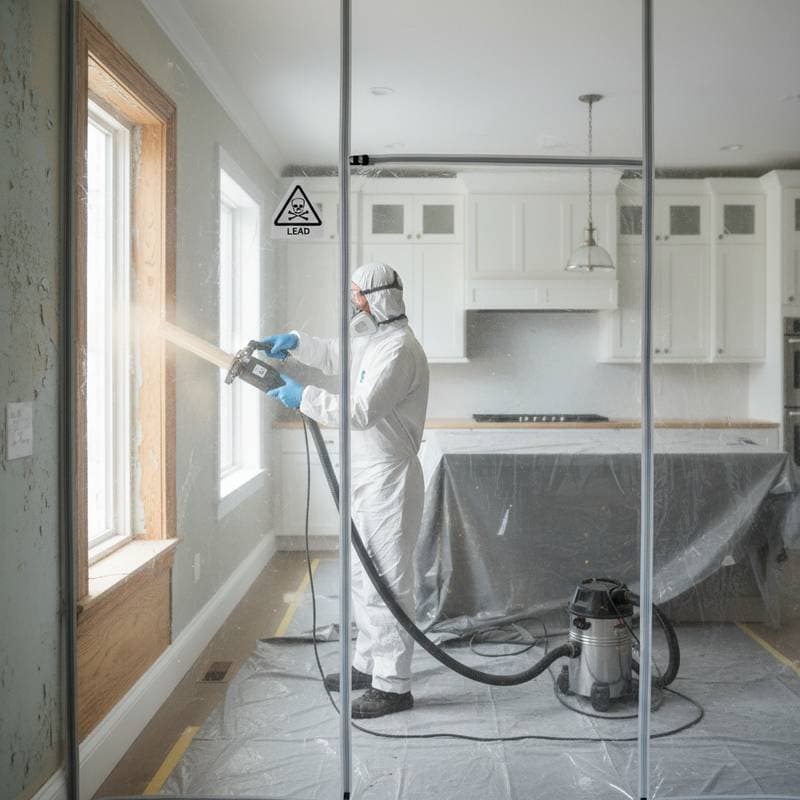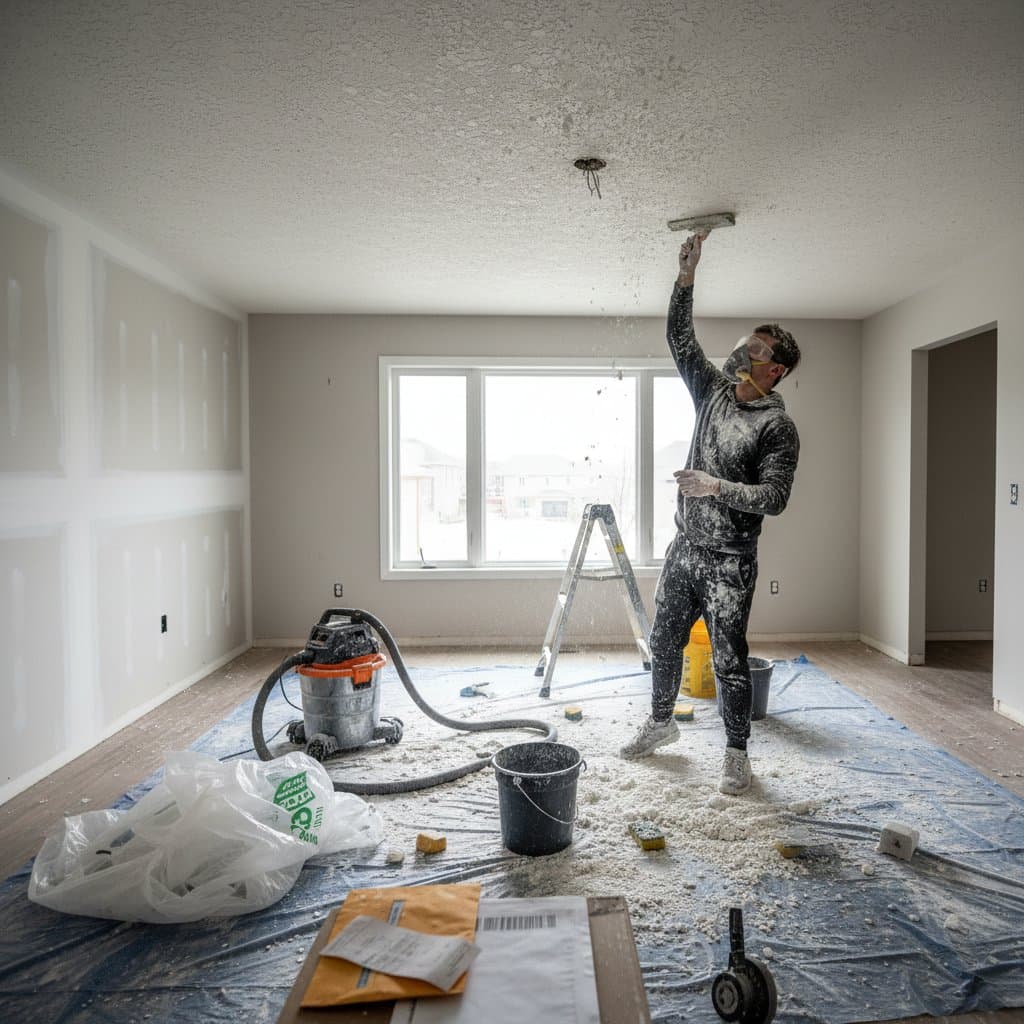Why Popcorn Ceilings Scare Off Contractors
Popcorn ceilings, once a popular choice for concealing imperfections in older homes, now pose significant challenges for contractors. These textured surfaces turn routine renovation tasks into complex operations fraught with risks and expenses. Homeowners seeking to update their spaces must recognize these issues to plan effectively and avoid surprises.
Contractors approach popcorn ceilings with caution due to safety hazards, intensive labor requirements, and variable costs. Addressing these elements early allows for smoother projects and better outcomes.
Factors Affecting Popcorn Ceiling Removal Costs
Several key elements influence the expense and effort involved in removing popcorn ceilings. Professionals evaluate these before providing estimates to ensure accurate pricing.
1. Asbestos Content
Homes built before 1980 frequently feature popcorn ceilings with asbestos fibers for fire resistance. Testing confirms presence, which mandates certified removal protocols. Abatement services typically cost between $5 and $10 per square foot, prompting contractors to require confirmation before starting work.
2. Labor Intensity
Scraping the texture demands careful, time-consuming effort as it adheres firmly to the underlying surface. Even modest areas require multiple hours, followed by repairs to any damaged drywall. This extended process heightens the chance of project overruns and additional charges.
3. Surface Preparation and Cleanup
The removal generates substantial dust that requires strict containment measures, such as plastic barriers and specialized ventilation equipment. Protective gear for workers adds to the setup time. Thorough cleanup afterward often equals the removal duration, effectively doubling labor expenses.
4. Ceiling Height and Accessibility
Elevated ceilings complicate the task, necessitating scaffolds or extension tools that slow operations and increase safety risks. Projects with ceilings above nine feet incur premium rates to account for extended setup and worker fatigue.
5. Desired Finish Quality
Post-removal, the surface demands patching and finishing to achieve a uniform appearance. A smooth result involves skim coating and sanding, which elevates costs compared to applying a subtle texture. Choices here directly impact both aesthetics and budget.
Why Contractors Often Refuse Popcorn Ceiling Jobs
Beyond financial considerations, unpredictability drives contractors to decline these assignments. Experienced teams weigh multiple risks before committing.
1. Hidden Asbestos Liabilities
Disturbing potential asbestos without testing violates regulations and exposes firms to lawsuits. Only licensed specialists handle confirmed cases, so general contractors refer out or avoid entirely to sidestep complications.
2. Low Profit Margins
Clients frequently underestimate the preparation and follow-up needed, pushing for low bids. With high material and disposal fees, margins shrink, making alternative projects more appealing.
3. High Mess Factor and Customer Dissatisfaction
Dust infiltration remains a concern despite precautions, potentially leading to disputes over residue in living areas. Negative feedback from such incidents discourages contractors from taking on the work.
4. Ceiling Damage and Repair Uncertainty
Revealed surfaces may hide cracks, stains, or structural issues requiring unforeseen fixes. These discoveries extend timelines and budgets, eroding trust in initial quotes.
Detailed Cost Analysis by Finish Level
| Finish Type | Basic Range | Standard Range | Premium Range | Key Differences |
|---|---|---|---|---|
| Asbestos-free removal | $1 - $2 | $2 - $3 | $3 - $4 | Includes basic scraping and light texture |
| Asbestos abatement | $5 - $7 | $7 - $9 | $9 - $10 | Features certified handling and disposal |
| Post-removal refinishing | $0.75 - $1.50 | $1.50 - $2.50 | $2.50 - $4.00 | Covers patching, smoothing, and painting |
These ranges reflect variations based on asbestos status and finish preferences. Adding paint afterward contributes $1 to $2 per square foot, resulting in totals of $4 to $6 per square foot for complete professional results.
Value and Return on Investment
Removing popcorn ceilings enhances home appeal by creating brighter, more spacious interiors that align with current tastes. Updated surfaces improve listing photos and draw serious buyers, often yielding a strong return through higher sale prices.
Maintenance benefits include simpler cleaning and repainting on smooth ceilings, reducing ongoing efforts compared to textured ones that collect debris. These advantages make the investment worthwhile for long-term ownership or resale.
Money-Saving Strategies
Strategic choices help control costs while maintaining quality.
- Conduct an asbestos test upfront to identify risks and select appropriate services.
- Prepare the space independently by protecting furnishings and sealing off areas, which cuts contractor time.
- Time the project for off-peak seasons, such as winter, when rates may drop due to lower demand.
- Select a light texture over full smoothing to minimize finishing labor.
- Bundle removal with related tasks like wall painting to share setup expenses.
Planning Your Budget
Develop a realistic budget by obtaining multiple quotes after testing. Factor in a 10 to 15 percent buffer for surprises like repairs. Track expenses across testing, removal, and finishing to stay on course.
Frequently Asked Questions
1. What is the average cost for popcorn ceiling removal?
Standard projects range from $2 to $5 per square foot, covering removal and basic refinishing. Asbestos involvement or premium smoothing can push costs to $10 per square foot.
2. What factors have the biggest impact on removal costs?
Asbestos presence, ceiling elevation, finish specifications, and labor demands drive expenses most. Larger or higher spaces amplify these effects through added equipment and time.
3. How can I save money on my project without sacrificing quality?
Test early, manage prep tasks, book during quiet periods, and choose efficient finishes. These steps preserve standards while optimizing spending.
4. Should I hire professionals or attempt this as a DIY project?
Professionals suit older homes or extensive areas for safety and precision. DIY fits small, verified asbestos-free sections but demands proper tools and containment.
5. How do I budget for unexpected costs?
Incorporate a 10 to 15 percent contingency fund. This allocation handles potential drywall fixes or extra finishing needs.
6. When is the best time to schedule popcorn ceiling removal?
Opt for late fall or winter to benefit from reduced rates and availability. Mild weather supports faster drying and completion.



